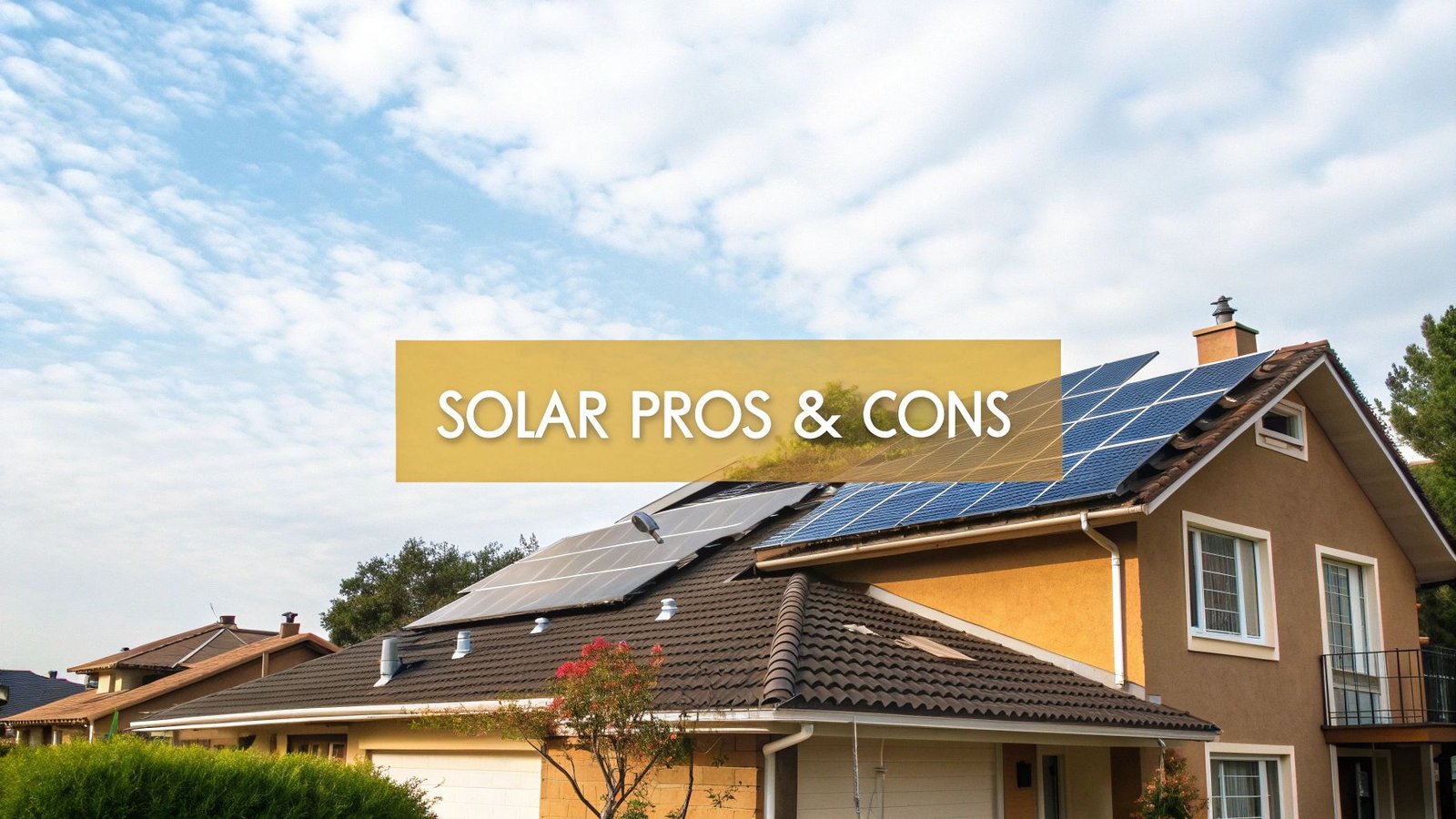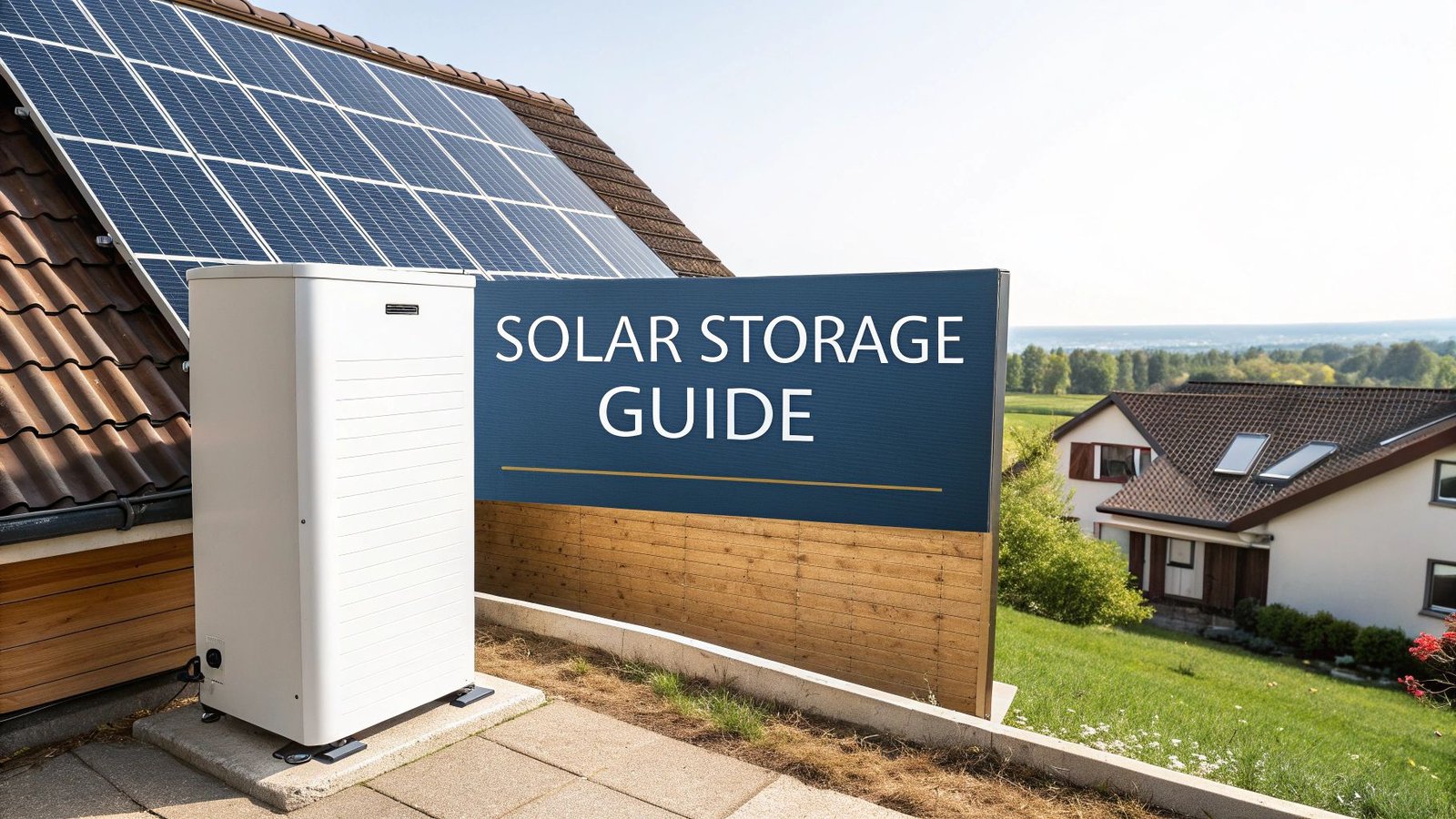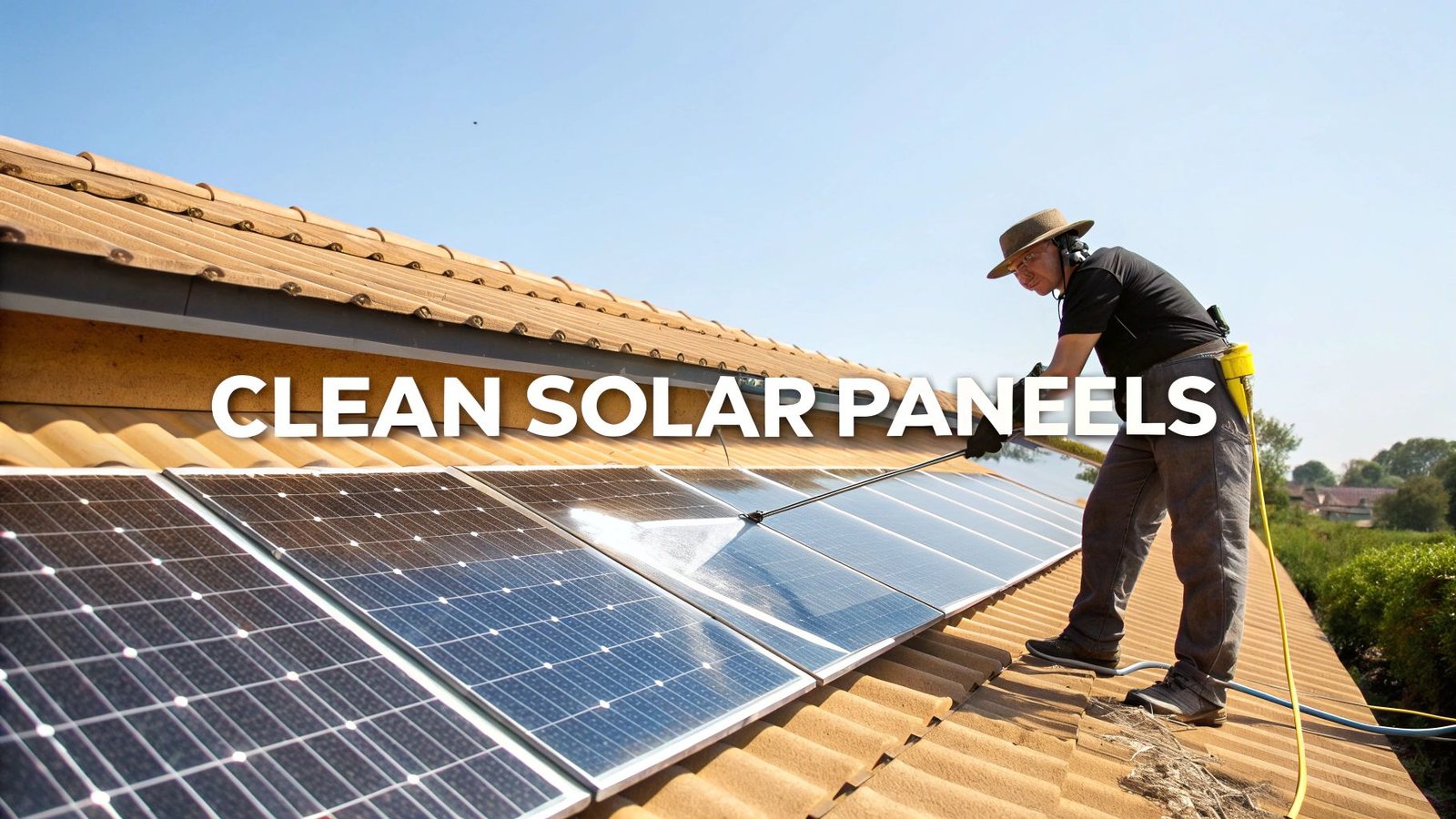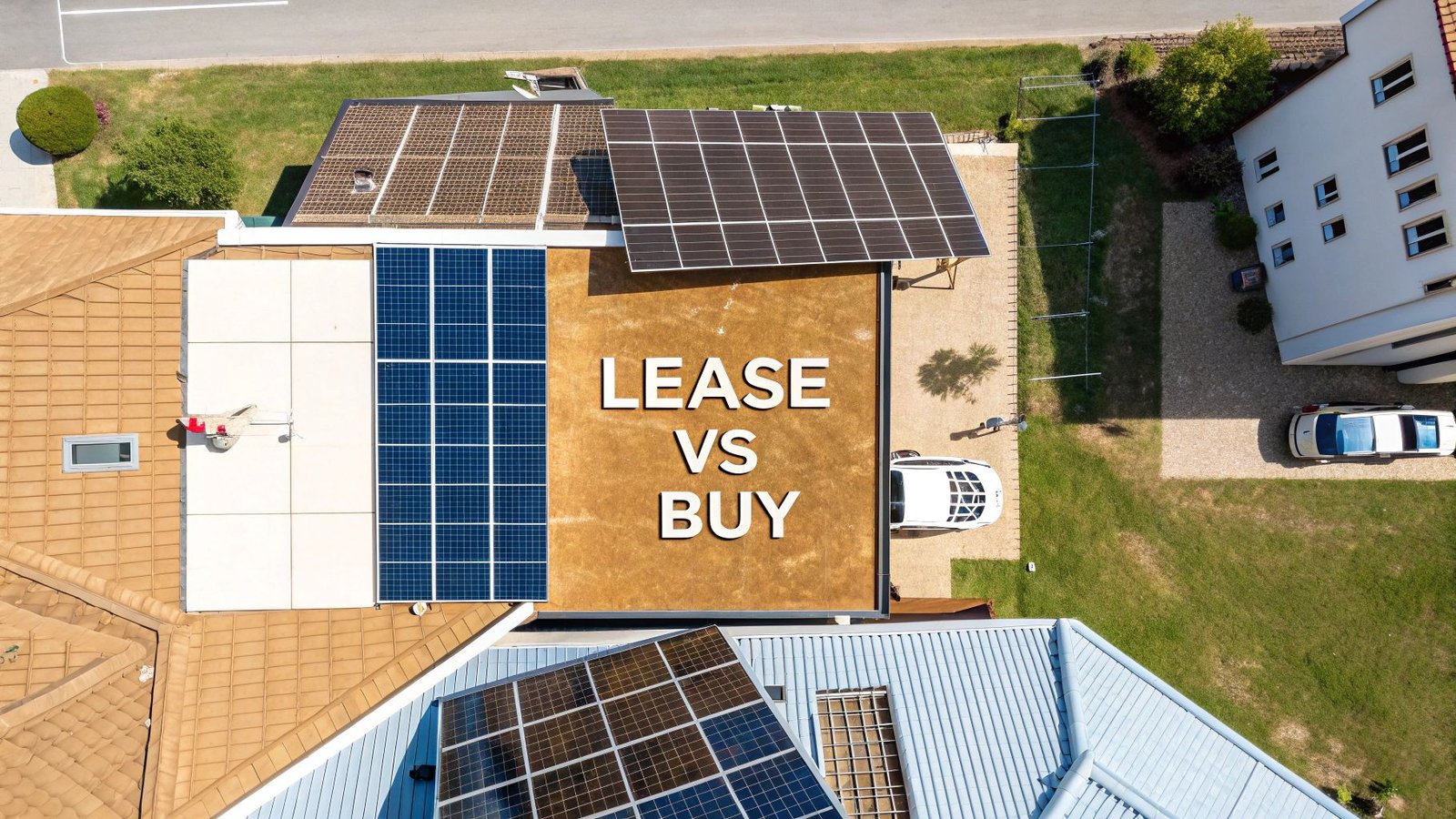Thinking about going solar? It's a big decision, and it really comes down to weighing the incredible long-term perks against some of the upfront realities. On one side, you have the promise of much lower electricity bills and a sense of energy independence. On the other, there's the substantial upfront cost and the simple fact that panels need sunlight to work.
Ultimately, whether solar is the right move for you boils down to your finances, where you live, and what your long-term goals are.
Is Solar Power a Smart Investment for You?
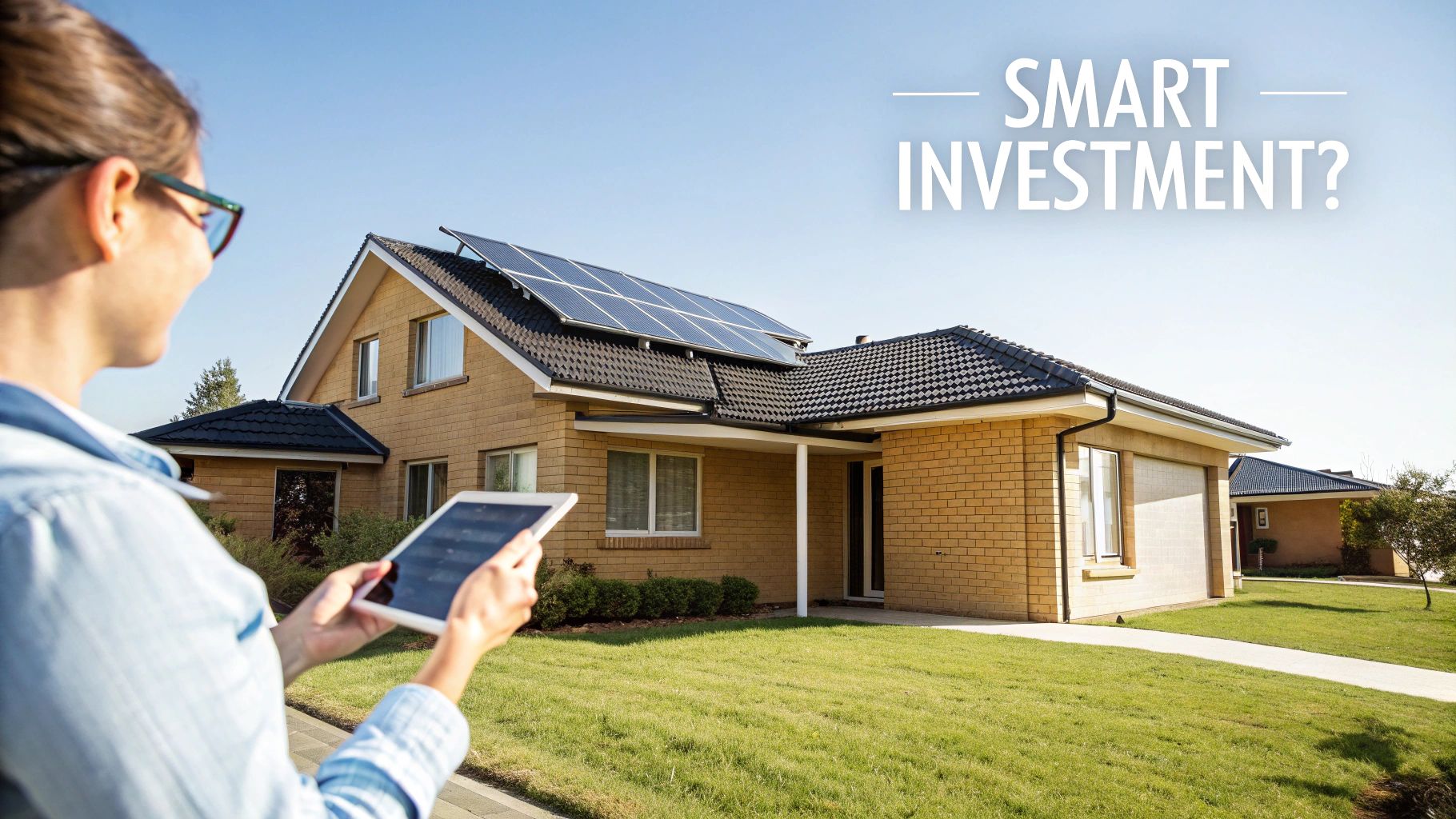
Jumping into solar is a major financial commitment, so it's smart to look at it from every angle. It's not unlike buying a new car—you wouldn’t just look at the gas mileage. You'd also think about the sticker price, ongoing maintenance, and whether it actually fits your family's needs. The pros and cons of solar power are much the same; they go far beyond just the savings on your monthly bill.
Of course, the appeal is easy to see. Imagine generating your own clean power right from your rooftop, drastically cutting—or even completely wiping out—your monthly utility bill. Doing so locks in your energy costs for decades, giving you a powerful shield against the unpredictable rate hikes we often see from traditional power companies.
Weighing the Key Factors
But let's be realistic: getting started comes with a significant financial hurdle. The average cost for a residential solar system hovers around $21,600 before any incentives kick in. That's a number that requires some serious thought, whether you're paying cash or financing.
While fantastic tax credits and local rebates can bring that number down, the initial investment remains the biggest roadblock for most homeowners.
To lay it all out clearly, I've put together a quick comparison of the main trade-offs you'll be considering.
Solar Power at a Glance: Pros vs. Cons
This table gives you a straightforward, side-by-side look at what you can expect when you invest in a residential solar panel system.
| Key Benefits (The Upside) | Key Challenges (The Downside) |
|---|---|
| Huge reduction in your monthly electricity bills. | The initial installation cost can be quite high. |
| More independence from the utility grid and its rate hikes. | Power generation depends entirely on the weather and sunshine. |
| A much smaller carbon footprint and a positive environmental impact. | Not every roof is ideally shaped or positioned for panels. |
| Great access to government incentives and tax credits. | The actual value of your savings can be tied to local utility policies. |
While this table hits the high points, a truly informed decision requires a much deeper dive. The next sections will unpack each of these points in detail to help you determine if solar energy is truly worth it for your specific home and situation.
The Financial and Environmental Perks of Going Solar
When you start digging into the pros and cons of solar power, the advantages really stand out, especially when it comes to your wallet and your conscience. For most homeowners, the biggest draw is pretty simple: a much smaller electricity bill, or maybe even no bill at all. When you generate your own power, you're essentially freezing your energy costs for the next couple of decades, insulating yourself from the unpredictable rate hikes that utility companies are known for.
This isn't just about saving a few bucks here and there; it's about setting yourself up for long-term financial stability. Sure, there's an upfront cost, but that investment pays for itself over time. Once it's paid off, you're looking at years and years of nearly free electricity. Plus, government incentives like the federal solar tax credit can take a serious chunk out of that initial price tag, making the switch to solar more attainable than ever. This credit lets you deduct a hefty percentage of your system's total cost right off your federal taxes.
Seeing Your Savings Grow Over Time
It's one thing to talk about savings, but it's another to actually see how they stack up over the long haul. Utility costs are only going one way—up. Meanwhile, once your solar system is paid for, the energy it produces is free.
This graph really drives the point home, showing the ever-widening gap between what you'd pay the utility company and your costs with solar over a 25-year span.
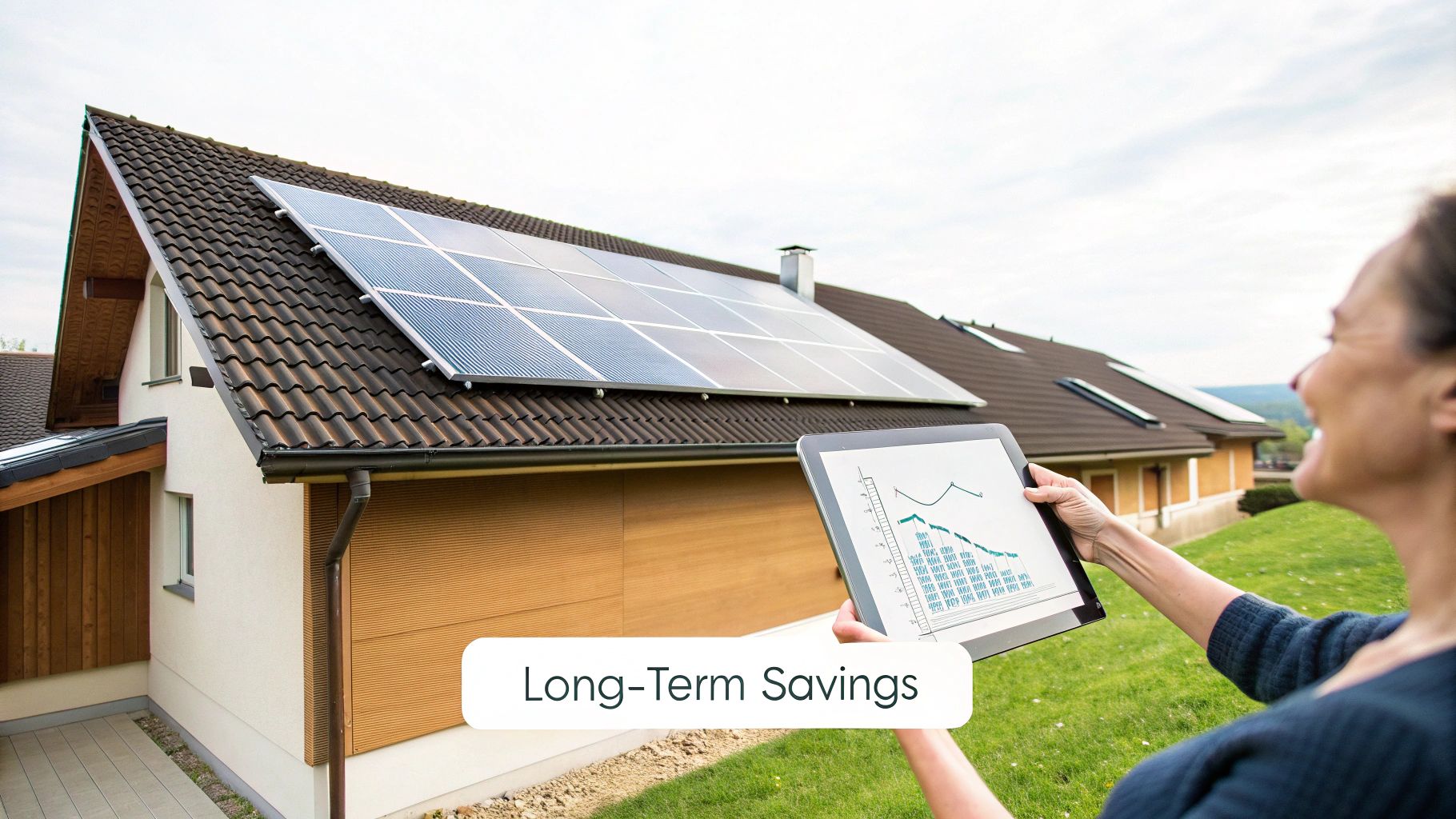
As you can see, the savings aren't just a trickle; they become a flood over the years, proving that solar is a powerful long-term investment.
More Than Just Savings: Home Value and Energy Freedom
The benefits don't stop with your monthly bills. Adding solar panels is a major home improvement that can directly increase your property's value. In fact, research consistently shows that homes with solar panels tend to sell for more than similar homes without them. So, you're not just cutting costs; you're building long-term equity.
On top of that, solar gives you a real sense of energy independence. By producing your own power, you're no longer completely at the mercy of an aging and sometimes fragile public grid. If you pair your panels with a battery storage system, you can even keep the lights on during a blackout, which is a fantastic source of security and peace of mind.
This push for self-sufficiency is happening on a massive scale. Solar is now the fastest-growing source of new electricity on the planet. In the first half of one recent year, global solar installations jumped by a staggering 64% compared to the year before, adding 380 gigawatts of new capacity. This explosive growth is fueled by falling prices and a worldwide effort to embrace cleaner energy. You can read more about the global solar boom to see just how quickly things are changing.
Lo más importante: Going solar is about so much more than a lower utility bill. It's a smart financial move that boosts your home's value, gives you energy security, and lets you play a part in creating a healthier planet by shrinking your carbon footprint.
The Practical Realities and Hurdles of Solar Power
Let's be honest, while the idea of harnessing the sun's power is exciting, it's not all sunshine and savings. Going solar is a major decision, and it’s smart to walk into it with your eyes wide open to the real-world challenges.
The biggest hurdle for most people? The high upfront cost. Even with prices dropping over the years, installing a full solar system on your home is a serious financial undertaking. That initial price tag isn't just for the shiny panels you see on the roof; it's a package deal for everything needed to get you up and running.
Breaking Down the Initial Investment
When you get a quote for a solar installation, you're paying for a lot more than just the panels. Here’s a quick look at where the money goes:
pie
title Solar System Cost Breakdown
"Solar Panels" : 40
"Inverter" : 15
"Labor & Installation" : 30
"Permitting & Inspection" : 15
- Solar Panels: These are the stars of the show, but they're only one part of the total cost.
- Inverter: This is the unsung hero. It’s a critical piece of hardware that converts the direct current (DC) power from your panels into the alternating current (AC) your appliances actually use.
- Labor and Installation: You're paying for trained professionals to safely install the panels, handle all the complex wiring, and make sure everything meets safety standards. This isn't a DIY weekend project.
- Permitting and Inspection: Your local city or county has rules to follow. These fees cover the necessary permits and official inspections to ensure your system is installed correctly and is safe for you and the grid.
Beyond the cost, there's the simple fact that solar power is intermittent. In other words, your panels only make electricity when the sun is out. This total reliance on daylight and good weather creates a variability you have to account for. Cloudy days, storms, and, of course, nighttime all mean your production drops to zero.
This inconsistency brings up both economic and technical hurdles. To have power 24/7, you often need to invest in battery storage, backup generators, or stay connected to the main grid. On a larger scale, integrating lots of solar power can sometimes put a strain on existing grid infrastructure. If you're curious about the bigger picture, you can discover more insights about solar integration on solarpowereurope.org.
Key Consideration: Without a battery to store your excess energy, your home will automatically switch back to pulling power from the utility company at night or during a string of rainy days.
Finally, you have to consider the physical realities of your own property. The truth is, not every roof is a great fit for solar. Things like the direction your roof faces, how much usable space you have, and whether nearby trees or buildings cast shadows can dramatically affect how much power your system can generate. A frank look at these potential downsides is the best way to make a decision you'll be happy with for years to come.
Calculating Your Solar ROI and Payback Period
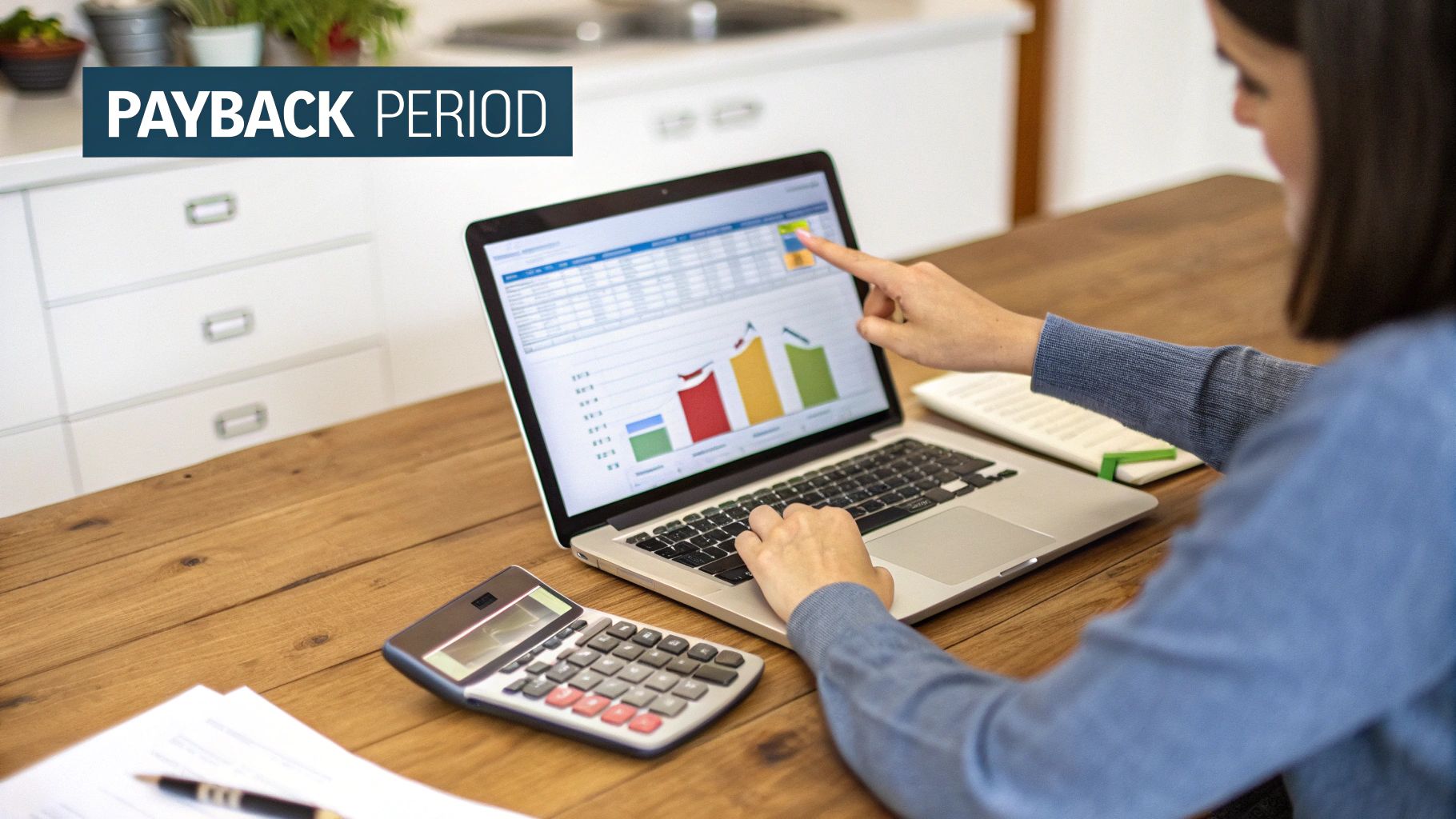
This chart gives you a quick visual on how much location matters. It's no surprise that sun-drenched areas in the Southwest break even on their solar investment much faster than folks in the Midwest and Northeast.
When you weigh the pros and cons of solar power, it almost always boils down to the money. The upfront cost is a hurdle, no doubt about it. But the long-term savings can be a game-changer. To really figure out if solar makes sense for you, you need to get familiar with two key ideas: Return on Investment (ROI) and the payback period.
Think of the payback period as your break-even point. It’s the time it takes for the money you've saved on electricity bills to completely pay off the initial cost of your solar panels. After that, you’re in the clear. Every bit of power your system generates is essentially free electricity for the rest of its 25 años de por vida.
The Basic Math Behind It
To get a handle on your payback period, you just need to work with a few key numbers. A professional quote will give you the most accurate figures, but you can get a pretty good ballpark estimate on your own. For a deeper dive into the financial side of things, it’s helpful to understand how to calculate return on investment (ROI) as it applies to energy savings.
Let's walk through a quick, simplified example:
- Figure Out Your Net Cost: Start with the total price tag for installation—let's say it's $21,600. Now, subtract any credits. The Crédito fiscal federal 30% is a big one, bringing your actual cost down to $15,120.
- Estimate Your Yearly Savings: Grab your last 12 electricity bills and find out what you spend annually. If your average bill is $150 a month, that’s $1,800 a year you're handing over to the utility.
- Calculate the Payback Period: Now, just divide your net cost by your annual savings: $15,120 / $1,800 = 8.4 years.
In this scenario, your system pays for itself in a little over eight years. That leaves you with nearly 17 years of free power. Pretty compelling, right?
For a more tailored estimate, plugging your numbers into a dedicated solar return on investment calculator can give you a much clearer picture based on your home’s specifics.
Información clave: Your payback period isn't a fixed number—it's directly tied to your local electricity prices, how much sun your roof gets, and what state or local incentives you can claim.
To give you a clearer idea of how these factors play out across the country, here’s a look at some typical scenarios.
| Region (Climate Zone) | Average System Cost | Estimated Payback Period | Estimated 25-Year Savings |
|---|---|---|---|
| Southwest (Hot/Dry) | $18,500 | 6–9 years | $45,000+ |
| Northeast (Cold/Humid) | $22,000 | 8–11 years | $35,000+ |
| Midwest (Mixed-Humid) | $20,000 | 10–13 years | $30,000+ |
| Southeast (Hot/Humid) | $19,000 | 9–12 years | $32,000+ |
As you can see, higher sun exposure and utility rates in regions like the Southwest can lead to significantly faster payback and greater long-term savings.
Understanding Other Key Financial Perks
Beyond the simple payback calculation, other policies are in place to make solar an even better deal.
Net metering, for example, is a fantastic arrangement where your utility company has to give you credit for the extra electricity your panels produce and send back to the grid.
On a sunny afternoon, your meter might literally spin backward as you bank those credits. You can then draw on them at night or during a string of cloudy days. These policies are huge for maximizing your ROI because they ensure you get value from every single kilowatt-hour your system generates. This directly helps shorten your payback period and makes the financial case for solar that much stronger.
The True Environmental Impact of Solar Panels
Solar power gets a lot of praise for being a "green" energy source, and for good reason. But to get the full picture, we need to look beyond just the clean electricity it produces. The real story involves the entire life of a solar panel, from the factory floor to the day it's retired. It’s a story with some trade-offs, but one that ultimately has a very positive ending.
The benefits during a panel's working life are genuinely massive. A standard home solar setup can prevent about 100,000 pounds of carbon dioxide from entering the atmosphere. To put that in perspective, that’s like planting nearly 1,000 trees. Every single day your panels are working, they're cutting down on the air pollution and massive water usage that comes with traditional power plants.
Manufacturing and What Happens at the End
Of course, getting to that point of clean energy production has its own environmental costs. The biggest one comes from manufacturing. It takes a good deal of energy to mine raw materials like silicon and assemble all the high-tech parts. If you're curious about what's inside, we have a guide that breaks down the componentes de un panel solar.
This infographic gives a great visual summary of the environmental give-and-take across a panel's entire life.
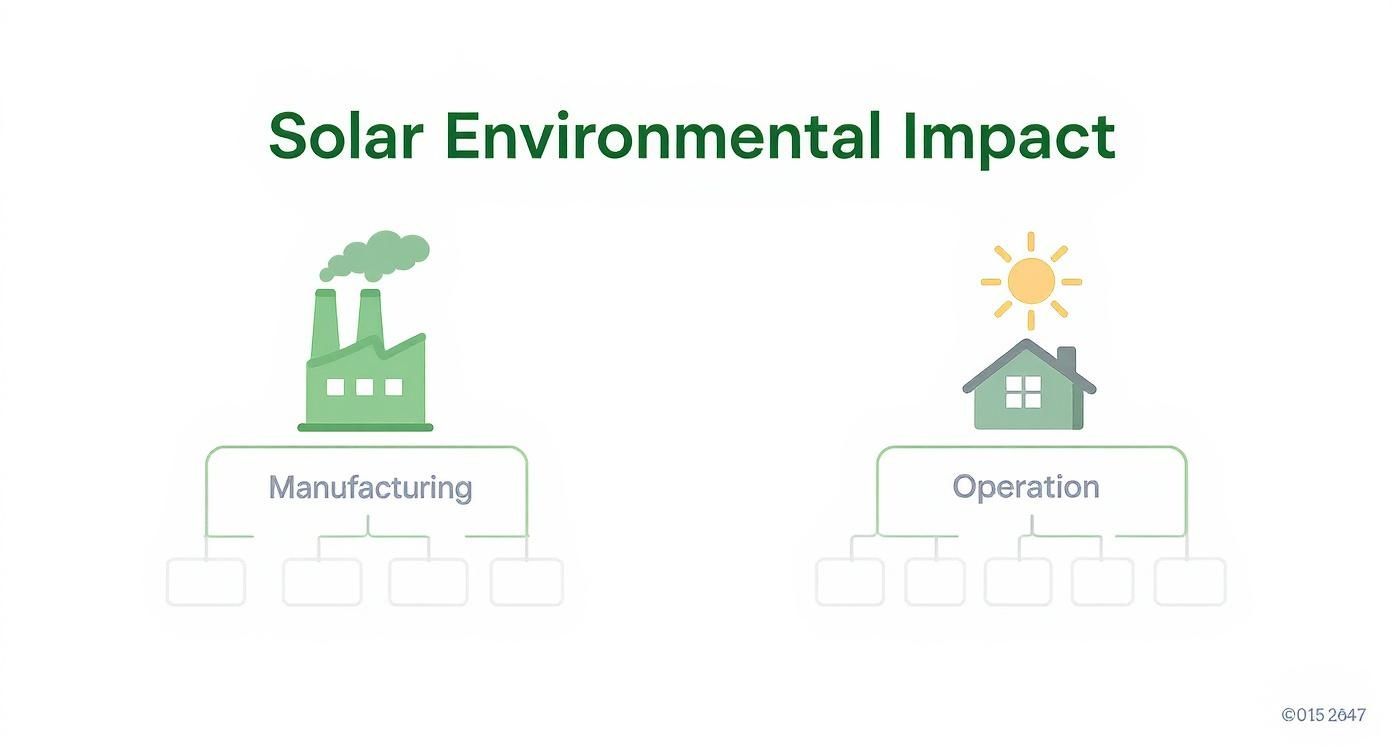
As you can see, the environmental impact is almost entirely front-loaded. You have the initial hit from manufacturing, followed by decades of clean energy payback.
The other big conversation happening right now is about what to do with panels once they’ve served their time. With a typical lifespan of De 25 a 30 años, they don’t last forever. The first wave of home solar installations is starting to reach retirement age, which means the industry is working hard to create better recycling programs. Keeping old panels out of landfills is a top priority.
Información clave: Even with the energy used in manufacturing, a solar panel pays back its "energy debt" in just one to four years. After that, it's all net-positive clean energy.
So, when you weigh everything, the environmental math for solar is overwhelmingly positive. Yes, there's an initial cost to the planet, but it's paid back quickly. What you're left with is more than two decades of clean, reliable electricity that makes a real difference.
A Practical Checklist for Your Solar Decision
Figuring out if solar power makes sense for you really boils down to your specific circumstances. To get a clear picture, you need to shift from general pros and cons to what it all means for your own home and finances. This checklist is built to help you do just that.
Think of it as a starting point. Answering these questions honestly will help you understand the major factors that will influence your experience with solar.
Key Questions to Ask Yourself
Before you start getting quotes or talking to installers, take a few minutes to think through these fundamental points. Your answers will quickly tell you if solar is a viable option for you today.
-
How much sun does your roof actually get? Look at your roof throughout the day. Are there large trees or neighboring buildings that cast shadows, especially in the afternoon? A south-facing roof is the gold standard, but don't discount east-west facing roofs, which can also be very productive.
-
What's your typical monthly electric bill? The more you're currently paying for electricity, the quicker you'll see a return on a solar investment. If your bill is consistently over $100 a month, solar often becomes a very smart financial move.
-
How long are you planning to live in your house? To get the most financial benefit, you'll want to be in your home long enough to reach the payback period. This is the point where your energy savings equal the cost of the system, and it usually takes around 8-12 years.
-
What shape is your roof in? Solar panels come with a warranty for 25 años—they're built to last. If you think your roof might need to be replaced in the next 5-10 years, it's much smarter and cheaper to do it antes de the panels go up.
Getting a handle on the installation process itself is also a big piece of the puzzle. You might find a comprehensive guide to solar panels on your roof useful for understanding what's involved.
Next Step: If your answers suggest solar is a strong possibility, your next move is clear: reach out and get at least three different quotes from well-regarded, certified solar installers. This will give you a real-world look at costs and equipment choices.
Still Have Questions About Going Solar?
Even after weighing all the pros and cons, it's completely normal to have a few lingering questions. Switching to solar is a big step for any homeowner, so let's clear up some of the most common things people ask.
What Happens to the Extra Power My Panels Make?
This is probably one of the most popular questions we hear. What happens on a bright, sunny afternoon when your panels are cranking out more electricity than your home is actually using?
That extra power doesn't just disappear. Thanks to a system called net metering, it’s sent back into the local electrical grid. Your utility company then gives you a credit for that energy, which you can use later when your panels aren't producing, like at night or on a cloudy day. Think of it like rolling over your unused cell phone data, but for electricity.
A Quick Heads-Up: Net metering rules are not the same everywhere. They can change quite a bit depending on your state and even your specific utility company. It's really important to look into the local policies, because they directly affect how much money you can save.
How Long Do Solar Panels Actually Last?
Solar panels are built to be incredibly tough and last for a very long time. Most high-quality panels come with a 25-year performance warranty, but that’s not their expiration date. Many continue to produce clean energy for decades beyond that. The chart below shows the typical degradation rate.
xychart-beta
title "Typical Solar Panel Performance Over Time"
x-axis [0, 5, 10, 15, 20, 25, 30]
y-axis "Guaranteed Output (%)" [80, 100]
line [100, 98, 96, 94, 92, 90, 88]
line [100, 97.5, 95, 92.5, 90, 87.5, 85]
They're also surprisingly low-maintenance. For most people, a good rainstorm is all it takes to wash off any dust or pollen. A quick check-up by a professional every few years is a great way to make sure everything is still working as efficiently as possible.
Do Panels Still Work When It's Cloudy or Snowy?
They sure do. Solar panels can generate power even on overcast days because they absorb any available light, not just direct, bright sunshine. Their output will be lower, of course, but they don't just shut down.
Here’s a fun fact: a panel’s efficiency can actually go up in colder weather. So, while you'll naturally get less power during shorter winter days, a crisp, cool, sunny day can be a powerhouse for your system.
Will Installing Solar Panels Damage My Roof?
This is a perfectly reasonable worry, but a professional installation is designed to protect your roof, not harm it. A good installer uses specialized mounting hardware and sealants to ensure your roof remains completely waterproof and structurally sound.
The key is choosing a certified and experienced installation team. They'll know exactly how to work with your specific type of roof to make sure the system is secure and leak-free for years to come.
Ready to find out if solar makes sense for you? The team at Energía radiante can give you a free quote with no strings attached and answer any other questions you have. You can learn more and get started on their website.

